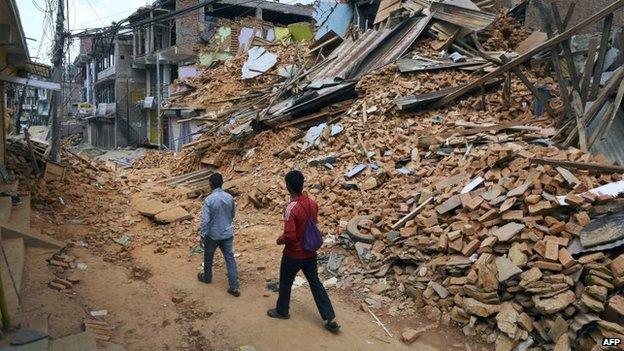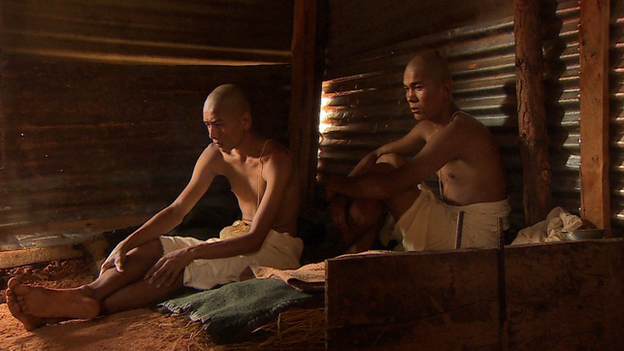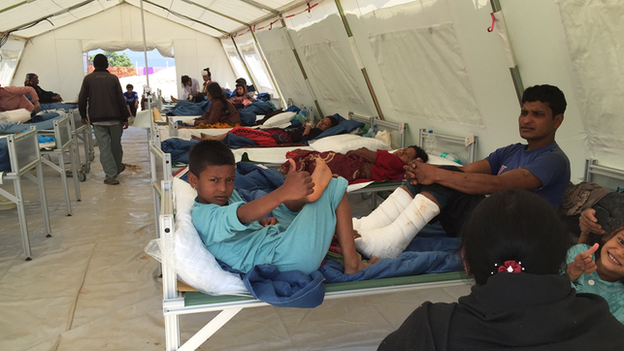Nepal earthquake: A legacy of fear in Chautara
- Published
The BBC's Justin Rowlatt in Chautara says the town has suffered '"appalling devastation"
Life had been returning to normal in Chautara; a pretty little town perched on top of a steep hill some 50km (31 miles) east of Kathmandu.
Like elsewhere in Nepal, most people had left the makeshift camps of ragged tents and flapping tarpaulins they had taken shelter in after the first giant quake.
They had been patching their houses up and dusting things down. Building little shacks if their homes had been destroyed. Anything to keep off the coming monsoon rains.
Then on Monday, another huge earthquake hit and changed everything.
The magnitude scale used to measure earthquakes is deceptive; it doesn't show a steady, linear progression but a logarithmic one.
Each point in the scale represents 32 times the energy released. So the first quake, at 7.8, had far more force than this week's 7.3 tremor.

The town of Chautara was devastated by a second earthquake that struck only two weeks after the first
And, compared with that first major quake, the death toll is expected to be tiny, less than a hundred.
That is in part because Nepal was far better prepared this time around. There is no shortage of emergency aid, no shortage of willing hands to help.
Nevertheless this latest earthquake has done terrible damage.
Anjun Bista had driven into town on his motorbike to pick up some emergency relief for his family, a tent and some food.
His mother died in the first earthquake and the family home was completely destroyed.
Mr Bista was on the main road through town when the great tremor rocked Chautara, rocked Nepal. He was crushed when a building collapsed.

"My world has been destroyed" says Bely, Anjun Bista's wife.

Her sons have shaved their heads in mourning
His wife Bely was wearing the white robes of mourning when I met her in the lean-to that her husband had been building before he died. Her face was slack with misery.
"My world has been destroyed," she told me. "He was such a hardworking happy man, such a good man."
Her two sons were crouching in the family's corrugated iron cabin. They were also wearing white and had shaved their heads to leave one sprout of hair on the crown - another mark of grief here in Nepal.
"I am like a house without a foundation," she said and sighed heavily. "I don't think I'll ever feel safe again."
Falling apart
That awful sense of insecurity is very common here in Nepal, and not just among those who have lost loved ones.
In some ways Chautara was lucky when this second earthquake struck. Relief supplies were already in the town.
Since the first earthquake, a neat tented village has grown up on a dusty field near the centre of town. It is a distribution centre for aid to the district and contains a large Red Cross field hospital.
The Red Cross has been treating victims of the earthquakes at a field hospital
Ranveig Tveitnes works with the Norwegian Red Cross and is in charge of the hospital.
She says the most shocking thing about the latest earthquake wasn't the terrible injuries that some people had suffered: "We're used to those, we know how to deal with them."
It was the fear in people's eyes as they rushed out of their houses to the safety of the open space.
"It had been two weeks before the previous big one," she explained, "and things had just started to settle down. The kids are laughing again and people are smiling and seeing that there could be a better future and then this comes and everything falls apart again in people's minds".
She says her team is bringing in trauma counsellors to help local people come to terms with their fear.
It is, she acknowledges, a bigger challenge than fixing a broken leg, amputating an infected finger or even performing a skin graft - just some of the 1,000 operations the Red Cross hospital in Chautara has performed in the 10 days since it opened.

Trauma counsellors will begin working in the hospital to help people come to terms with their fear
Tackling this terrible legacy of fear is a bigger challenge than treating physical injuries, in part because Nepalese people are right to feel frightened.
According to seismologists the pressure in the great plates that are driving together beneath the country has not yet been released.
There will be more earthquakes in Nepal.